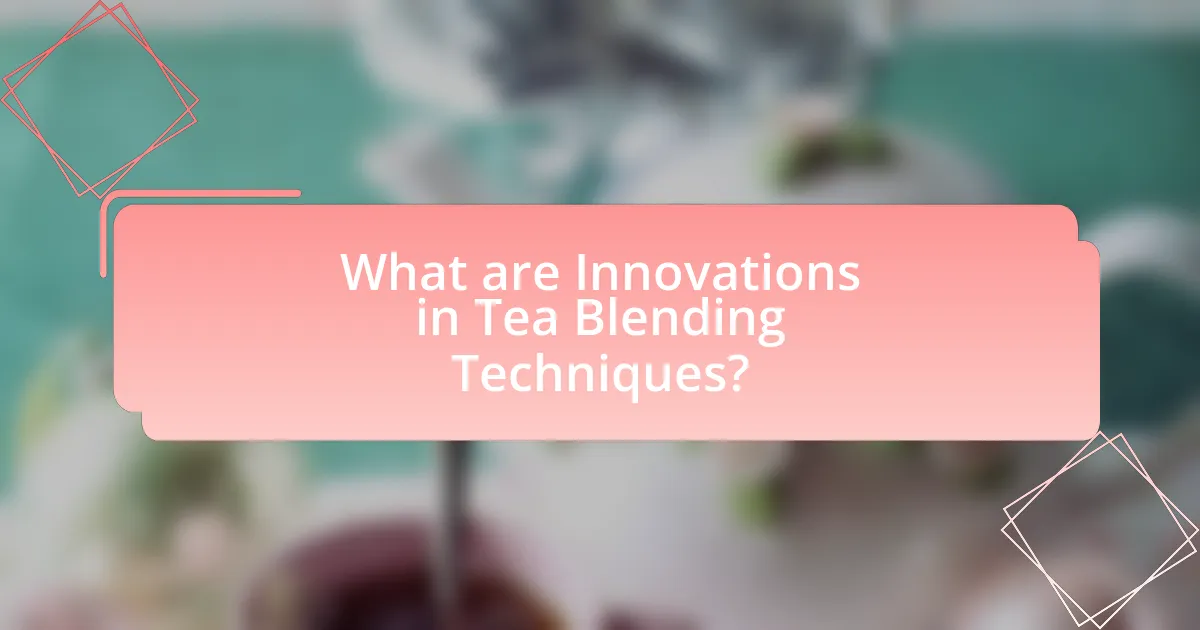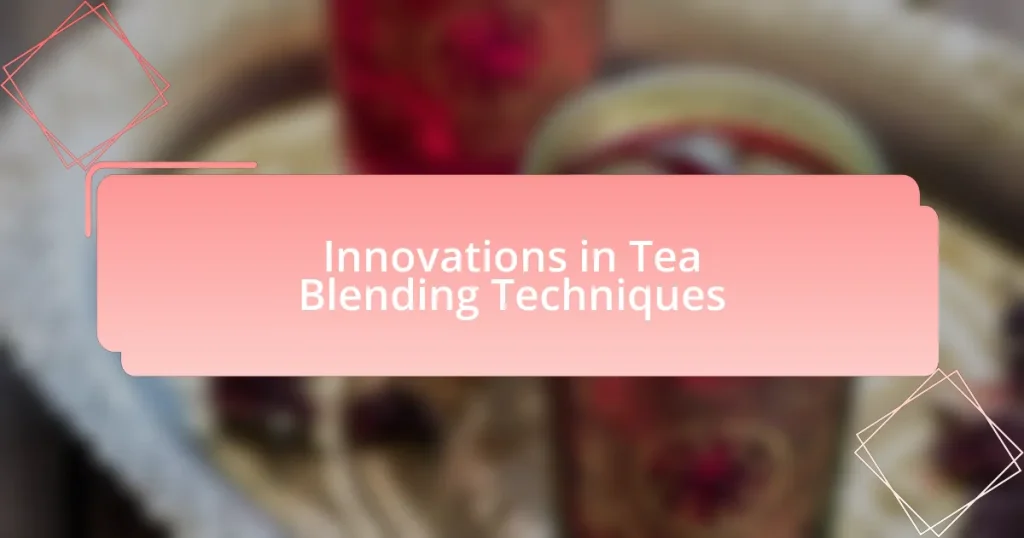The article focuses on innovations in tea blending techniques, highlighting advancements such as flavor profiling, precision blending technology, and the use of artificial intelligence for taste optimization. It discusses the evolution of traditional blending methods influenced by historical trade and cultural practices, as well as the role of technology in enhancing flavor consistency and consumer satisfaction. Key trends include the incorporation of functional ingredients and sustainability practices, while challenges in adopting new techniques are also addressed. The article concludes with insights into future prospects for tea blending innovations, emphasizing the importance of adapting to consumer preferences and emerging technologies.

What are Innovations in Tea Blending Techniques?
Innovations in tea blending techniques include the use of advanced flavor profiling, precision blending technology, and the incorporation of artificial intelligence for taste optimization. Advanced flavor profiling allows blenders to analyze and replicate complex flavor compounds, enhancing the overall taste experience. Precision blending technology utilizes automated systems to ensure consistent ratios and quality in blends, which improves product reliability. Additionally, artificial intelligence analyzes consumer preferences and market trends, enabling blenders to create customized blends that cater to specific demographics. These innovations are supported by research indicating that technology-driven approaches can significantly enhance flavor consistency and consumer satisfaction in the tea industry.
How have traditional tea blending methods evolved?
Traditional tea blending methods have evolved significantly due to advancements in technology and changing consumer preferences. Historically, tea blending involved manual processes where skilled artisans combined various tea leaves to achieve desired flavors and aromas. With the introduction of modern machinery, blending has become more efficient, allowing for precise control over the proportions and consistency of blends. Additionally, the rise of global trade has expanded access to diverse tea varieties, enabling blenders to experiment with unique combinations that cater to a broader range of tastes. This evolution reflects a shift towards innovation in flavor profiles and the incorporation of ingredients such as herbs and spices, enhancing the overall tea experience.
What historical influences shaped modern tea blending?
Historical influences that shaped modern tea blending include the British colonial expansion in the 18th and 19th centuries, which facilitated the introduction of diverse tea varieties from regions like India and China. The British East India Company played a crucial role in this process by establishing trade routes and promoting the consumption of tea in Europe, leading to the blending of different tea types to cater to varying tastes. Additionally, the development of tea blending techniques was influenced by cultural exchanges, such as the incorporation of local herbs and spices into tea blends, which reflected regional preferences and traditions. These historical factors contributed to the evolution of modern tea blending practices, resulting in a wide array of flavors and styles that are prevalent today.
How do cultural practices impact tea blending innovations?
Cultural practices significantly influence tea blending innovations by shaping flavor preferences, blending techniques, and ingredient choices. For instance, in regions like China, traditional tea ceremonies emphasize specific flavor profiles and aromas, leading to the development of unique blends that cater to these cultural tastes. Additionally, cultural rituals surrounding tea consumption, such as the Japanese tea ceremony, prioritize harmony and balance, prompting innovations that focus on achieving these qualities in blends. Historical practices, such as the use of local herbs and spices in Indian chai, have also driven the creation of innovative blends that reflect regional identities and culinary traditions. These cultural contexts not only dictate the types of teas blended but also inspire new combinations and methods, thereby continuously evolving the tea blending landscape.
What role does technology play in tea blending innovations?
Technology plays a crucial role in tea blending innovations by enhancing precision and efficiency in the blending process. Advanced analytical tools, such as gas chromatography and mass spectrometry, allow tea producers to analyze the chemical composition of different tea leaves, ensuring optimal flavor profiles. Additionally, machine learning algorithms can predict consumer preferences based on historical data, enabling companies to create blends that cater to specific market demands. For instance, the use of automated blending machines increases consistency and reduces human error, leading to higher quality products. These technological advancements not only streamline production but also foster creativity in developing unique tea blends that appeal to diverse consumer tastes.
How are data analytics used in developing new blends?
Data analytics are utilized in developing new blends by analyzing consumer preferences, flavor profiles, and market trends. This analytical approach allows companies to identify popular ingredients and combinations that resonate with target demographics. For instance, data from sales and customer feedback can reveal which flavors are trending, enabling blenders to create products that align with consumer demand. Additionally, advanced analytics can assess the chemical composition of various tea leaves, helping to optimize blends for taste and health benefits. This data-driven methodology enhances the likelihood of successful product launches, as evidenced by companies that have successfully introduced new blends based on insights derived from comprehensive data analysis.
What advancements in machinery have improved blending processes?
Advancements in machinery that have improved blending processes include the development of high-shear mixers, automated blending systems, and advanced control technologies. High-shear mixers enhance the uniformity of blends by applying intense mechanical forces, which effectively break down particles and promote thorough mixing. Automated blending systems increase efficiency and consistency by allowing precise control over ingredient ratios and blending times, reducing human error. Advanced control technologies, such as real-time monitoring and feedback systems, enable operators to adjust parameters dynamically, ensuring optimal blending conditions. These innovations collectively lead to higher quality blends and improved production efficiency in the tea blending industry.
What are the key trends in tea blending techniques today?
Key trends in tea blending techniques today include the use of innovative flavor profiles, the incorporation of functional ingredients, and a focus on sustainability. Innovative flavor profiles often combine traditional tea bases with exotic fruits, herbs, and spices, appealing to diverse consumer preferences. The incorporation of functional ingredients, such as adaptogens and superfoods, caters to health-conscious consumers seeking wellness benefits from their beverages. Additionally, sustainability practices in sourcing and blending are increasingly prioritized, with brands focusing on organic and ethically sourced ingredients to meet consumer demand for environmentally friendly products. These trends reflect a shift towards personalization and health in the tea industry, supported by market research indicating a growing interest in unique and health-oriented tea experiences.
How are flavor profiles being enhanced through blending?
Flavor profiles are enhanced through blending by combining different tea varieties to create complex and balanced flavors. This technique allows for the integration of diverse taste notes, such as floral, fruity, and earthy elements, resulting in a more nuanced beverage. For example, blending a robust black tea with a delicate green tea can yield a harmonious profile that highlights the strengths of both. Additionally, the use of flavoring agents, such as herbs and spices, in conjunction with traditional tea leaves further enriches the overall taste experience, catering to a wider range of consumer preferences.
What new ingredients are being incorporated into tea blends?
New ingredients being incorporated into tea blends include adaptogenic herbs, superfoods like matcha and spirulina, and unique botanicals such as hibiscus and elderflower. Adaptogenic herbs, such as ashwagandha and reishi mushroom, are gaining popularity for their stress-relief properties. Superfoods like matcha provide a rich source of antioxidants and are increasingly used for their health benefits. Additionally, botanicals like hibiscus offer vibrant color and tart flavor, enhancing both the aesthetic and taste profile of tea blends. These trends reflect a growing consumer interest in health and wellness, driving innovation in tea blending techniques.
How do innovations in tea blending affect consumer preferences?
Innovations in tea blending significantly influence consumer preferences by introducing unique flavors and health benefits that cater to evolving tastes. For instance, the incorporation of superfoods like matcha or adaptogenic herbs into traditional blends has attracted health-conscious consumers seeking functional beverages. A study by the Tea Association of the USA indicates that 80% of consumers are more likely to purchase tea that offers added health benefits, demonstrating a clear shift towards blends that align with wellness trends. Additionally, innovative flavor combinations, such as floral and fruity infusions, have expanded the market, appealing to younger demographics who prioritize variety and novelty in their beverage choices. This trend is supported by market research from Grand View Research, which projects that the global specialty tea market will reach $23.5 billion by 2027, driven by consumer demand for innovative and diverse tea experiences.
What challenges do tea blenders face in adopting new techniques?
Tea blenders face several challenges in adopting new techniques, primarily including resistance to change, the need for specialized training, and the integration of technology. Resistance to change often stems from established practices and traditions that blenders are accustomed to, making them hesitant to experiment with innovative methods. Additionally, new techniques may require specific skills or knowledge that necessitate training, which can be time-consuming and costly. Furthermore, integrating technology into blending processes can pose logistical challenges, such as the need for new equipment and adjustments to existing workflows. These factors collectively hinder the seamless adoption of innovative blending techniques in the tea industry.

What are the benefits of innovative tea blending techniques?
Innovative tea blending techniques enhance flavor profiles, improve health benefits, and increase market appeal. These techniques allow for the combination of diverse tea varieties and complementary ingredients, resulting in unique taste experiences that cater to consumer preferences. For instance, blending green tea with herbs like mint or spices like ginger can create beverages that not only taste better but also offer enhanced antioxidant properties. Additionally, innovative blending can lead to the development of functional teas that target specific health concerns, such as stress relief or digestive support, thereby attracting health-conscious consumers. The growing trend of artisanal and craft teas demonstrates the market’s demand for unique blends, indicating that innovative techniques can significantly boost sales and brand differentiation in a competitive industry.
How do these innovations enhance flavor and aroma?
Innovations in tea blending techniques enhance flavor and aroma by utilizing advanced methods such as precision blending, temperature control, and the incorporation of novel ingredients. Precision blending allows for the exact combination of tea leaves and flavoring agents, ensuring a consistent and balanced profile. Temperature control during the brewing process optimizes the extraction of volatile compounds responsible for aroma, leading to a more fragrant cup. Additionally, the introduction of unique botanicals and flavor enhancers, such as herbs and spices, expands the sensory experience, creating complex flavor profiles. These advancements are supported by studies showing that specific blending ratios and ingredient combinations can significantly impact the overall sensory attributes of tea, thereby validating the effectiveness of these innovations.
What specific techniques improve the sensory experience of tea?
Specific techniques that improve the sensory experience of tea include precise temperature control, optimal steeping time, and the use of high-quality ingredients. Temperature control is crucial as different tea types require specific temperatures to release their flavors effectively; for example, green tea is best brewed at 160-180°F, while black tea thrives at 200-212°F. Optimal steeping time enhances flavor extraction; over-steeping can lead to bitterness, while under-steeping may result in a weak taste. Additionally, using high-quality, fresh tea leaves and incorporating complementary ingredients, such as herbs or spices, can elevate the overall sensory profile, providing a richer aroma and taste. These techniques are supported by research indicating that proper brewing methods significantly influence the flavor and aroma of tea, enhancing the overall drinking experience.
How do blending innovations cater to health-conscious consumers?
Blending innovations cater to health-conscious consumers by creating tea blends that enhance nutritional value and promote wellness. These innovations often incorporate functional ingredients such as adaptogens, superfoods, and herbal components known for their health benefits, like antioxidants and anti-inflammatory properties. For instance, the addition of turmeric or ginger in tea blends has been shown to support immune health and reduce inflammation, appealing to consumers seeking natural health solutions. Furthermore, advancements in extraction and blending techniques allow for better flavor profiles without compromising health benefits, making these products more attractive to health-conscious individuals.
What impact do innovative blending techniques have on sustainability?
Innovative blending techniques significantly enhance sustainability in tea production by optimizing resource use and reducing waste. These techniques, such as precision blending and the use of natural flavor enhancers, minimize the need for synthetic additives and lower the environmental footprint of tea cultivation. For instance, research indicates that blending different tea varieties can improve crop resilience, leading to higher yields with less pesticide use, thereby promoting ecological balance. Additionally, sustainable sourcing practices integrated into blending processes ensure that tea is harvested from environmentally responsible farms, further supporting biodiversity and reducing carbon emissions associated with transportation.
How can blending practices reduce waste in tea production?
Blending practices can reduce waste in tea production by optimizing the use of various tea leaves that might otherwise be discarded. By combining lower-grade or surplus leaves with higher-quality ones, producers can create new blends that maintain flavor and quality, thus minimizing the amount of tea that goes to waste. For instance, research indicates that blending can utilize up to 30% of surplus leaves, transforming potential waste into marketable products. This approach not only enhances resource efficiency but also supports sustainability in the tea industry.
What sustainable sourcing methods are being utilized in blending?
Sustainable sourcing methods utilized in blending include direct trade, organic certification, and agroforestry practices. Direct trade establishes a direct relationship between producers and buyers, ensuring fair prices and better quality control, which has been shown to enhance sustainability in sourcing. Organic certification guarantees that the tea is grown without synthetic pesticides or fertilizers, promoting environmental health and biodiversity. Agroforestry practices integrate trees and shrubs into tea cultivation, improving soil health and reducing erosion, which contributes to a more sustainable ecosystem. These methods collectively support ethical sourcing and environmental stewardship in the tea blending industry.

What are the future prospects for tea blending innovations?
The future prospects for tea blending innovations are promising, driven by advancements in technology and consumer preferences for unique flavors. Innovations such as artificial intelligence and machine learning are being utilized to analyze flavor profiles and create customized blends, enhancing the personalization of tea experiences. Additionally, the growing trend towards health-conscious products is leading to the incorporation of functional ingredients, such as adaptogens and superfoods, into tea blends. Market research indicates that the global tea market is expected to grow significantly, with a projected CAGR of 5.5% from 2021 to 2026, highlighting the increasing demand for innovative tea products.
How might consumer trends shape future blending techniques?
Consumer trends will significantly influence future blending techniques by driving demand for unique flavor profiles and health-oriented blends. As consumers increasingly seek personalized and functional beverages, tea producers will adapt by experimenting with diverse ingredients and innovative blending methods. For instance, the rise in popularity of wellness-focused products has led to the incorporation of adaptogens and superfoods in tea blends, reflecting a shift towards health-conscious consumption. Additionally, market research indicates that 60% of consumers prefer products that offer unique flavor experiences, prompting brands to explore unconventional combinations and regional ingredients to meet these preferences. This alignment with consumer desires will shape the evolution of blending techniques, ensuring they remain relevant and appealing in a competitive market.
What emerging technologies could revolutionize tea blending?
Emerging technologies that could revolutionize tea blending include artificial intelligence (AI), blockchain, and advanced sensory analysis tools. AI can optimize blending processes by analyzing consumer preferences and predicting flavor profiles, leading to more personalized tea blends. Blockchain technology enhances traceability and transparency in sourcing tea leaves, ensuring quality and ethical practices. Advanced sensory analysis tools, such as electronic noses and tongues, can provide precise measurements of flavor compounds, enabling blenders to create consistent and high-quality products. These technologies collectively enhance efficiency, quality control, and consumer satisfaction in the tea blending industry.
How can tea blenders stay ahead of market demands?
Tea blenders can stay ahead of market demands by continuously innovating their blending techniques and incorporating consumer feedback into product development. By utilizing advanced technologies such as artificial intelligence and data analytics, tea blenders can analyze market trends and consumer preferences, allowing them to create unique blends that cater to evolving tastes. For instance, a report from Grand View Research indicates that the global tea market is expected to reach $73.3 billion by 2024, highlighting the importance of adapting to consumer trends. Additionally, engaging with customers through social media and surveys can provide valuable insights, enabling tea blenders to adjust their offerings in real-time and maintain a competitive edge.
What best practices should tea blenders adopt for innovation?
Tea blenders should adopt a customer-centric approach to innovation by actively engaging with consumers to understand their preferences and trends. This practice allows blenders to create unique blends that resonate with market demands, as evidenced by the rise in popularity of flavored and functional teas, which cater to health-conscious consumers. Additionally, leveraging technology for data analysis can help identify emerging flavor profiles and consumer behavior patterns, enabling blenders to stay ahead of the competition. Collaborating with suppliers for sustainable sourcing also fosters innovation, as it aligns with the growing consumer preference for ethically produced products.


